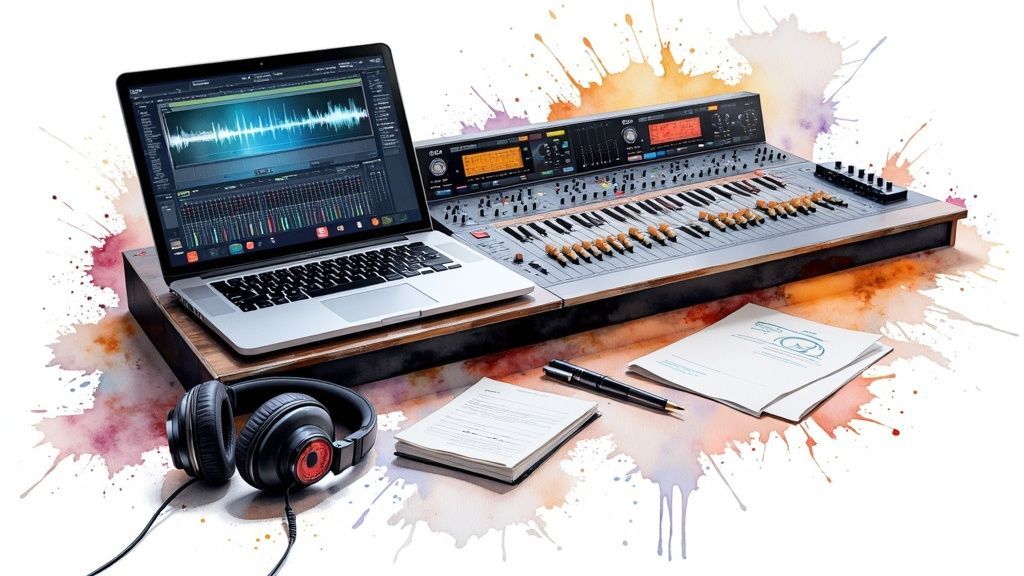
A solid audio post-production workflow is what separates amateur audio from a truly professional soundscape. It’s a structured journey that takes raw recordings and carefully shapes them into something polished and impactful. This process is the secret sauce behind great films, TV shows, and podcasts, moving methodically from organization and editing to sound design, mixing, and final delivery.
Let’s walk through the entire audio post-production pipeline, one stage at a time. I'll break down what happens at each step and show you how AI-generated sound effects, like those from SFX Engine, can fit right into a professional process.
Before you even think about touching a fader or adding an effect, you need to get organized. This initial stage is all about preparation, and honestly, it’s where most projects either succeed or fail. It’s not just about dumping files into a project folder; it's about building a solid foundation that will save you from headaches and creative dead-ends later on.
A huge part of this is getting on the same page with the director or client. You need to nail down a shared vision for the sound before you start making technical or creative choices.
The first, and arguably most important, meeting is the spotting session. This is where you sit down with the director and watch the project from start to finish. Together, you’ll pinpoint every single audio need. You'll make notes on which lines of dialogue are unclear, where a door needs to creak, where music should build tension, and, just as importantly, where silence will have the biggest impact.
The outcome of this session is your cue sheet—a detailed roadmap for the entire project's sound. Think of it as your blueprint. A good cue sheet turns subjective ideas about sound into a concrete, actionable checklist, making sure everyone is aligned from the get-go. I can’t tell you how many times a thorough spotting session has saved me days of rework down the line.
A project with a detailed cue sheet is a project set up for success. It transforms the subjective nature of sound into an actionable, objective checklist, ensuring everyone is aligned before the technical work begins.
If you want to get really organized, looking into Kanban best practices for workflow optimization can be a game-changer. It helps you visualize every task and keeps the whole team on track.
Once the creative vision is locked in, it's time to get your technical house in order. This means setting up your Digital Audio Workstation (DAW) and standardizing all your project's technical specs.
Everyone on the team needs to agree on a universal sample rate (typically 48kHz for video) and bit depth (usually 24-bit). This simple step prevents frustrating technical hiccups and endless file conversions later. It’s a bit of housekeeping that pays off big time.
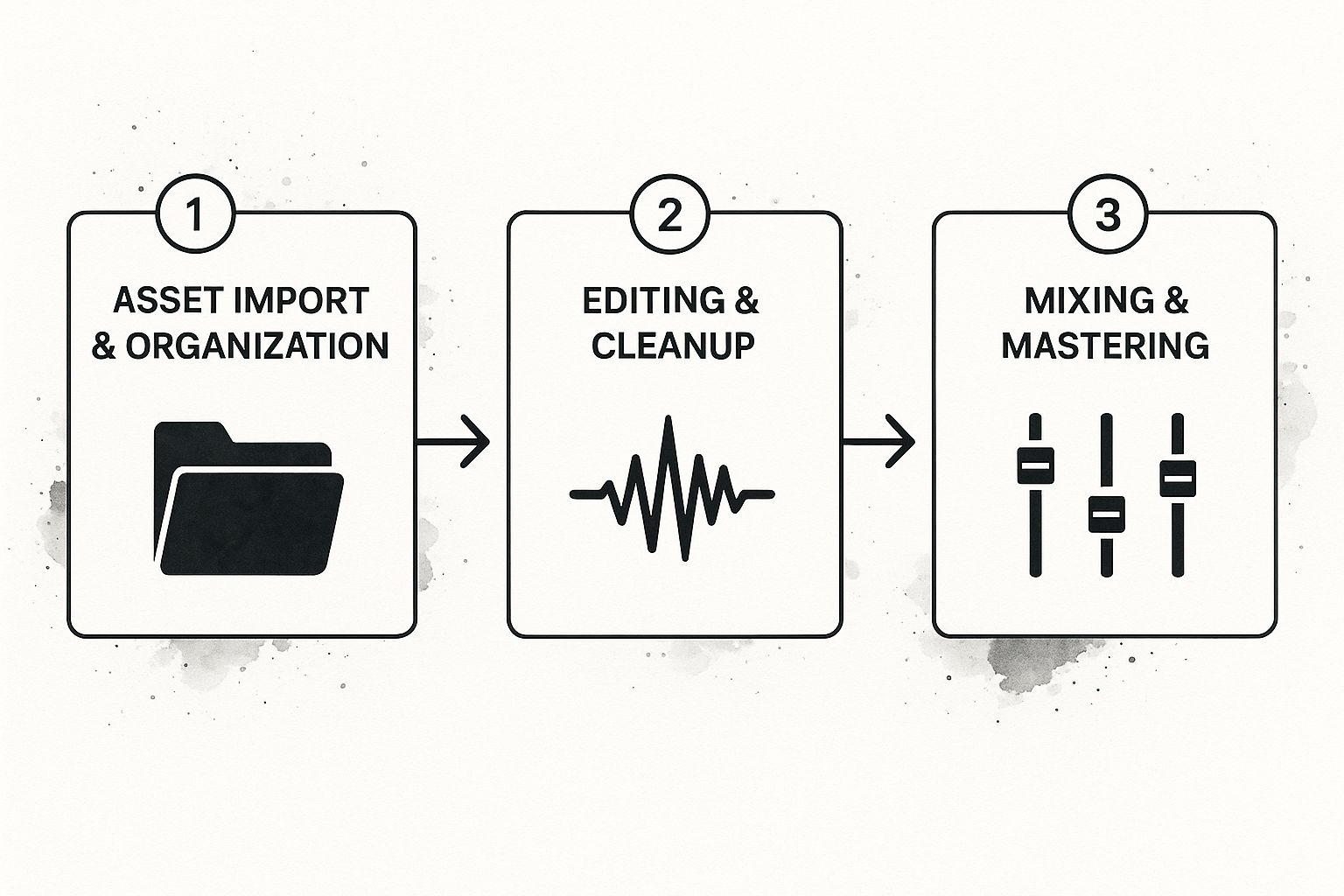
As you can see, a successful workflow is logical and linear. Each stage builds directly on the one before it. Putting in the effort to create a clean, organized, and technically sound setup right at the start is what allows creativity to flow freely through the rest of the post-production journey.
If your audience can’t understand what the characters are saying, the story is dead in the water. That’s why dialogue editing is arguably the most painstaking—and most crucial—part of the audio post-production workflow. It's a craft that goes so much deeper than just slapping on a noise reduction plugin.
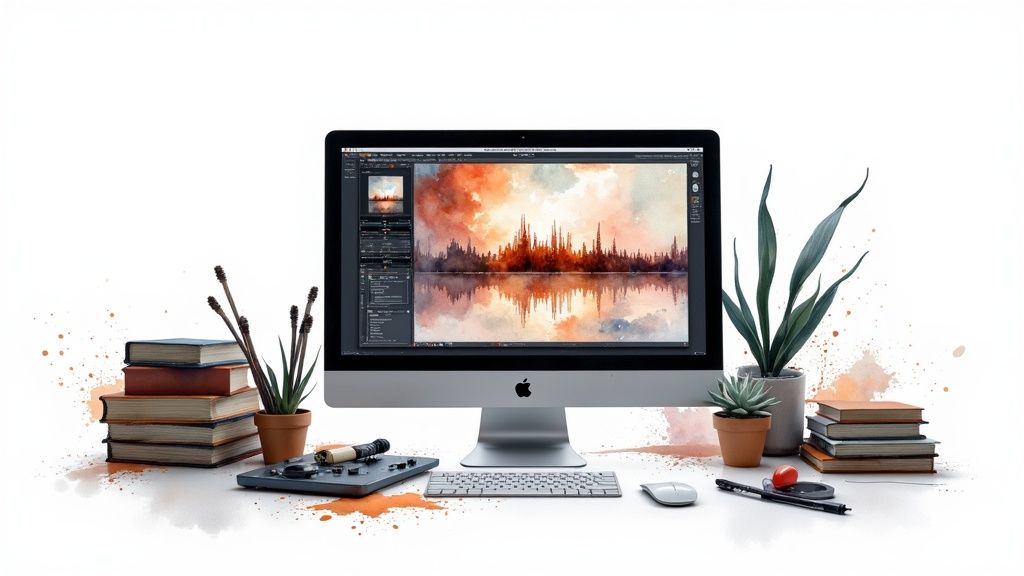
The first pass is always about surgical cleanup. I’m not talking about broad-stroke fixes; I’m talking about hunting down every little imperfection that could pull someone out of the moment.
After cleaning up the individual clips, the real art begins: making it all sound like one flawless, continuous performance. This is where mastering room tone is non-negotiable. Every space, from a car interior to a cathedral, has a unique sonic fingerprint—the quiet, ambient sound of the room itself.
I make it a rule to capture at least 30 seconds of clean room tone on every single set. This becomes my audio putty, the key to filling the tiny gaps between dialogue edits. By carefully crossfading this tone under every cut, you eliminate those unnatural drops to dead silence that give away your edits.
The best dialogue editing is invisible. You've succeeded when the audience doesn't even notice the edits. It all comes down to perfectly matched room tone, which creates a believable and consistent sonic world that keeps the viewer completely immersed.
Let's be realistic: sometimes a line of dialogue is just unsalvageable. Maybe an actor flubbed a line, or a passing siren completely drowned them out. When that happens, we turn to Automated Dialogue Replacement (ADR).
ADR involves bringing the actor back into a quiet studio to re-record the problematic lines while watching the scene. The editor's challenge, then, is to take that perfectly clean studio recording and make it sound like it belongs in the original, noisy scene. This means adding just the right amount of reverb to match the acoustics of the location and carefully EQing it to blend in. Getting this right is what separates an amateur mix from a professional, polished production.
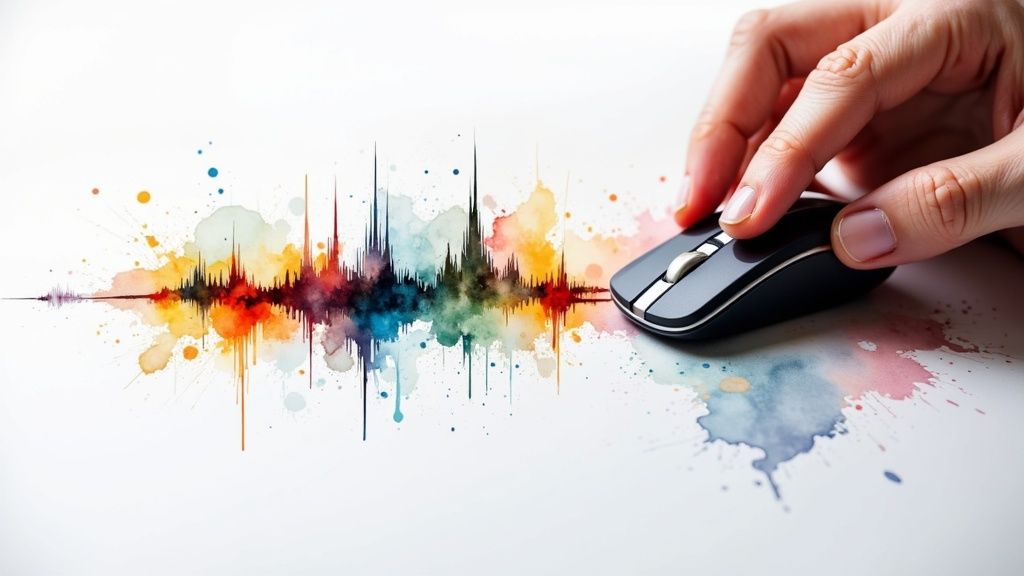
Once your dialogue is clean and sits nicely in the mix, we get to my favorite part of the process: sound design. This is where we stop fixing problems and start building a world from scratch. We’re moving beyond the technical and into the purely creative, taking a silent visual and giving it a pulse.
Sound design, at its core, is storytelling. It’s the art of layering atmospheres, Foley, and specific sound effects to construct a world that feels not just real, but emotionally resonant. It breathes life into the visuals, defines the space, and gives every action on screen a sense of weight and purpose.
For years, my sound design process revolved around massive, meticulously curated sound libraries. They're still a cornerstone of my work, but sometimes you hit a creative wall. What happens when a project demands a sound that just doesn’t exist in any library? This is where AI sound generation has become an absolute game-changer.
Let's say I'm working on a sci-fi film and need the sound of "a rusty spaceship door opening in a vast, echoing cavern." I could pull a generic "metal door" from a library and slap a "cave reverb" on it, but it almost always sounds tacked-on and fake.
Instead, I’ll turn to a tool like SFX Engine. I can feed it that exact descriptive prompt and get a unique, synthesized effect that perfectly captures the idea in my head. If you’re curious about how this works in practice, we have a whole guide on how to create sounds with AI-powered tools.
This AI-generated sound becomes my "hero" element. From there, I build around it, layering in more traditional sounds—maybe a real-world recording of fabric rustling for texture or a subtle, low-frequency rumble from a library to add scale. It’s a hybrid approach that gives you incredible creative freedom without sacrificing realism.
A compelling soundscape isn't just one sound; it's a careful construction of several distinct layers. Each one has a job to do, and a professional sound designer knows how to blend them so they feel like a single, cohesive environment.
The real magic of sound design lies in the blend. A great soundscape isn't just a collection of noises; it's a carefully composed piece where every element works together to support the story, guide the audience's emotions, and make the world on screen feel tangible.
The demand for this level of detail is exploding. In fact, the global audio post-production market is projected to hit around $8.92 billion by 2033. This growth is directly tied to audiences on streaming platforms and in cinemas wanting higher-quality, more immersive experiences, cementing the critical role sound design plays in modern media.
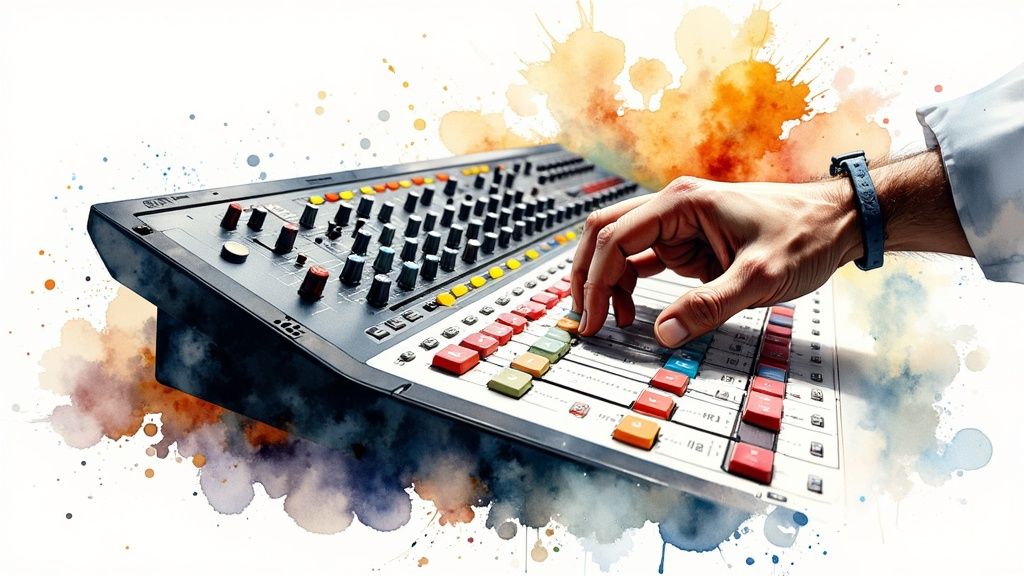
This is where everything comes together. All the careful editing and creative sound design choices now have to play nicely in the same space. Mixing is a delicate balancing act, a dance between dialogue, music, Foley, and sound effects to create a single, cohesive track that resonates emotionally.
A great mix isn't just about technical perfection. It's an art form that guides the listener's ear, directs their focus, and ultimately, deepens the story's impact.
The first, non-negotiable step is organization. You need to group your tracks into sub-mixes, often called stems. Creating separate stems for dialogue (DIA), music (MUS), and effects (SFX) is standard practice in any professional workflow. It keeps your session clean and is absolutely critical for creating final deliverables, especially the M&E (Music & Effects) track needed for international versions.
With your session tidy, the real work can start. The goal is to create clarity and separation, giving every sound its own place to live.
One of the most common pitfalls I hear in amateur mixes is "mud." It's that cluttered, undefined sound in the low-end where different elements are fighting for the same frequencies. The secret to avoiding this mess is strategic equalization (EQ).
Think of your EQ not as a volume knob, but as a sonic chisel. You're not just boosting things to make them louder; you're carving away frequencies to create room.
A great mix is built on subtractions, not just additions. By cutting frequencies from one element to make room for another, you create a cleaner, more powerful mix without a constant battle for volume.
Once your frequency balance is sorted with EQ, it's time to manage the volume levels with compression. A light touch of compression on your main dialogue bus can work wonders, evening out the performance by catching stray loud syllables and ensuring every word is heard without you having to ride the fader constantly. For sound effects, compression can add that extra punch and weight to things like explosions or door slams.
After that, you need to make all these different elements sound like they exist in the same physical space. That's a job for reverb. The dialogue you recorded in a booth (ADR), the Foley from the recording stage, and the sound effects from your library all need to sound like they're happening in the same room on screen. By sending a bit of each element to a shared reverb, you can "glue" the entire soundscape together into one believable world.
For an extra layer of sonic texture, you can even design unique sounds to complement your mix. Tools like a free AI sound generator are fantastic for creating custom ambiences or effects that fit your project perfectly.
Getting these details right is more important than ever. The post-production market, currently valued around $25.85 billion, is expected to soar to nearly $74 billion by 2034. This growth is fueled by massive audience demand for high-quality, immersive content on streaming services. You can read the full post-production market report to see how production houses are adapting.
You’ve tweaked, balanced, and polished your mix. Now comes the final, crucial step: mastering and delivery. This is where you put the final seal on your audio, ensuring it sounds incredible everywhere—from a booming cinema to a tiny smartphone speaker. Think of it as the last quality check before your work goes out into the world.
The most important part of modern mastering for video content is hitting the right loudness standard. Every platform, whether it’s Netflix, YouTube, or traditional broadcast, has its own technical requirements, usually measured in Loudness Units Full Scale (LUFS). If you miss the mark, your audio might get rejected outright or, just as bad, automatically squashed by the platform's algorithms, which can undo all your hard work.
For instance, broadcast and major streaming services often aim for a standard of -24 LUFS, while a platform like YouTube normalizes everything to around -14 LUFS. Knowing your target is non-negotiable.
Your best friends at this stage are a good limiter and a trustworthy metering plugin. The limiter is your safety net, catching any stray peaks before they distort without coloring the sound. The metering plugin gives you the hard data—LUFS, true peak, and dynamic range—to confirm you’ve nailed the specs.
Before you even think about hitting "export," it's time for one last, focused listen. This final Quality Control (QC) check is your last line of defense against any mistakes that may have slipped through the cracks. I always make a point to listen to the entire project from top to bottom, preferably on a different set of speakers or headphones than I used for mixing. A fresh perspective is invaluable.
Here’s what you're hunting for:
The final QC pass is an absolute must. It’s your last opportunity to fix an issue before it reaches the client and, ultimately, the audience. Investing an extra hour here can save you the headache and embarrassment of a revision request down the line.
Once you’ve signed off on the QC, you're ready to create the final files. Your client will usually give you a "delivery spec sheet" with their exact needs, but a standard delivery package nearly always includes two key things: the full mix and an M&E (Music & Effects) track.
The M&E is a version of your mix that contains all the music and sound effects but no dialogue. This is absolutely vital for international distribution, as it allows the project to be easily dubbed into other languages.
Getting this last step right is more important than ever. After recent slowdowns, the production industry is bouncing back with a renewed focus on high-quality content, fueling a projected 7% compound annual growth rate in spending. Studios are shifting from a quantity-first mindset to a quality-first one, and a polished, professional audio package is a huge part of that. You can discover more about the production industry's growth outlook and see why delivering flawless, spec-compliant audio is a ticket to success.
Even with the most dialed-in workflow, questions are a constant part of audio post-production. After years in the trenches, I've heard just about all of them. Here are some straightforward answers to the ones that pop up most often.
Nine times out of ten, the biggest hold-up is a messy handoff. The preparation stage is everything. When I get a project with poorly labeled files, conflicting sample rates, or—worst of all—no clear creative brief, I know we're in for a long ride.
Honestly, taking an extra hour to do a proper spotting session and check every single asset will save you days of headaches later. A clean, organized start is the single most important factor for a smooth project and a fantastic final mix.
You have to get out of your perfectly treated studio. Your mix doesn't live there—it lives on earbuds, laptop speakers, and in cars. That’s why you have to test it on everything.
Listen on your phone. Take it to your car. Plug in those cheap headphones that came with your last phone. This is the only way you'll catch major issues with dialogue clarity or realize your booming low-end completely disappears on small speakers. Also, make sure you're mastering to the correct LUFS target for each specific platform. It's not optional if you want your audio to sound consistent for the audience.
I always tell my team that a mix is only as good as it sounds on the worst device. If the dialogue cuts through on a tiny phone speaker, you've nailed it. It’s a simple gut-check that should be a mandatory part of your final QC.
This really comes down to what you're trying to achieve. I turn to AI tools like SFX Engine when I need something that simply doesn't exist in the real world. Think sounds like 'a bio-luminescent creature chittering in an alien jungle.' It’s an incredible tool for creating unique, signature sounds from scratch and breaking through creative blocks.
For everyday sounds—your basic footsteps, Foley, or door creaks—a high-quality traditional library is still my workhorse for its sheer realism and variation. The magic really happens when you blend the two:
An M&E track is a full mix of the project's Music and Effects, but with all the original dialogue completely removed. It is an absolutely critical deliverable for any project hoping for international distribution.
This track allows distributors in other countries to add new dialogue in their own language without having to recreate the entire sound design, Foley, and music score from the ground up. Delivering a clean, well-balanced M&E isn't just a technical requirement; it’s a mark of professionalism that's non-negotiable for most film and TV work.
Ready to create those sounds you can hear in your head but can't find anywhere? With SFX Engine, you can generate completely unique, high-quality sound effects from a simple text description. Stop digging through endless libraries and start creating the exact sound your project needs. Try our AI sound effects generator today and hear the difference. Explore your options at sfxengine.com.